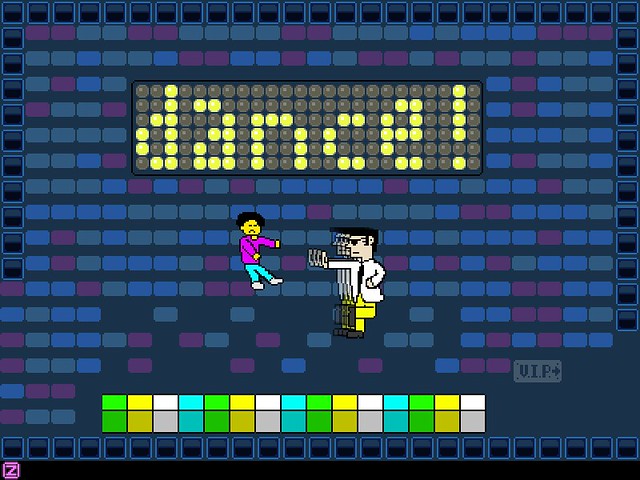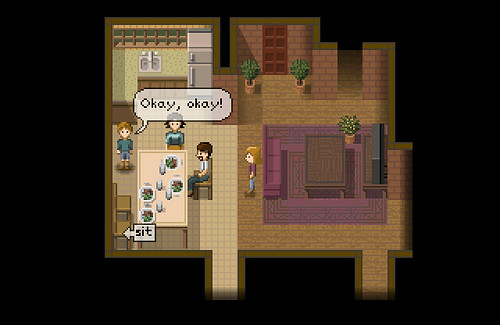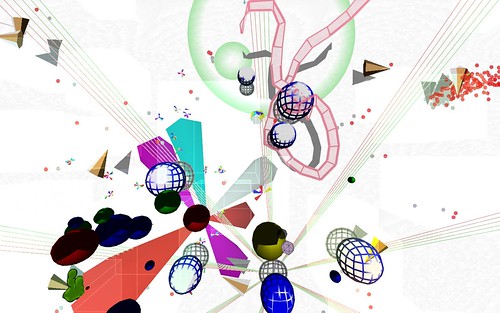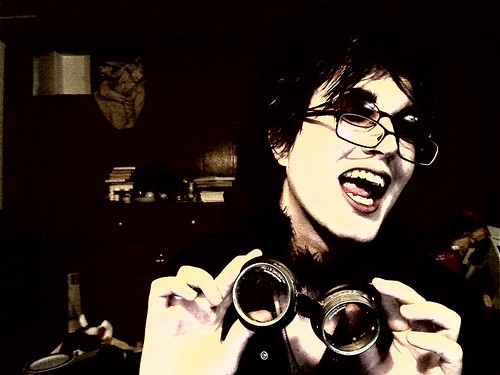Posts from ‘Unique / Bizarre’ Category
suteF
By: ithamore
On: January 25th, 2011
[This is a guest review by John Sandoval. To submit a guest article for TIGSource, go here.]
Edit: You might want to avoid the video if you don’t want to see any spoilers. /Edit
Nothing is as it seems in the world of suteF. Though what you see is a fairly standard puzzle-platformer (crates are pushed, ledges are climbed, and exits are ultimately reached), suteF is at its core a game that takes every opportunity to mess with the player as much as possible. A miscalculated jump can trigger cracks in reality; a single step could erase your path from existence. Entire dimensions can open up from the void. And this tension, this uncertainty, this feeling that anything can happen at any time, is what makes playing suteF an experience worth having.
The successor to creator Ted Lauterbach’s earlier work (titled Fetus), suteF places you once again in the role of an admittedly doughy little blue man named Aramas. Trapped in a hellish dimension, you must progress through five sets of levels, using your wits and Aramas’ limited skillset to solve increasingly complex puzzles and hopefully find a way out. Aramas has at his disposal three individual abilities— jumping, crate pushing, and grappling onto nearby surfaces with his trusty grappling hook. However, the game takes great delight in stripping you of any of these abilities when you least expect it, keeping you on your toes. In addition to Aramas’ inherent abilities, your greatest asset in escaping the world of suteF comes from the warped nature of the dimension itself. To put it simply, walking off one end of the screen leads you to the other; falling off the bottom of the screen loops you back to the top. Exploiting these spatial impossibilities can turn an otherwise impassable chasm into a mere few steps in the other direction. The resulting puzzles are exceptionally clever, forcing the player to make full use of all of Aramas’ paltry abilities in a multitude of ways. You’d be surprised just how much gameplay suteF ekes out of these relatively simple mechanics.
Every element in suteF is crafted to make the player feel as if the world could tear apart at any moment. From the constant screen static to sudden changes in the levels themselves, you’re never sure if what you’re playing is a glitch or the actual game. Some might call this a lack of polish—but I feel that the game is far more interesting for it.
suteF is available for download from GameJolt. It takes about one to two hours to beat; the various secret levels can double that time. All in all, it’s a very, very good game.
Disco? Very!
By: Derek Yu
On: January 6th, 2011
[This is a guest review by increpare. To submit a guest article for TIGSource, go here.]
This past Ludum Dare birthed a wonderful wonderful game which is also a terrible terrible pun (one so obvious and enticing in its awfulness that two people chose it as their title). Disco? Very! is this entirely beautiful game made by Tom 7.
IF YOU WANT TO PLAY IT THEN PLEASE BE CLICKING HERE (flash)
I found it a captivating, marveloquent piece of work, overflowing with soul and infinity.
Of course, there were several other games made as well for the jam. I’m simply too much of a lazy bastard to have even played them all. Of those that I have done, though, I will point to Cardboard Adventures and Dinosaur Dance-Off as being works of extreme culturotainment value.
One Arm at a Time – An Octodad Interview
By: Alehkhs
On: December 5th, 2010
Octodad is a quick little game, full of charm, put together by a team from DePaul University. Taking control of an octopus attempting to keep his cephalopod nature a secret from his human wife and children, the player must perform a to-do list of chores around the house. Sounds easy enough, right? But then you get to the controls, which are a perfect balance between ‘impossible to use’ and ‘insanely fun,’ and you begin your day in the life of Octodad.
Having played the game myself, and having enjoyed it thoroughly. I sat down to talk with some members the team behind the project. The interview is after the jump, but if you’ve never played Octodad yourself, then check out the trailer and then go grab a download for yourself.
___________________________________________________
Transformice
By: Derek Yu
On: June 20th, 2010
This is Transformice, and it is so much fun! There is an English version of the game available which now has quite a few people playing in it (the original game is in French). The video should explain the basics of how Transformice works, but there’s also a help menu available during the game.
Kometen (iPhone)
By: Derek Yu
On: May 28th, 2010
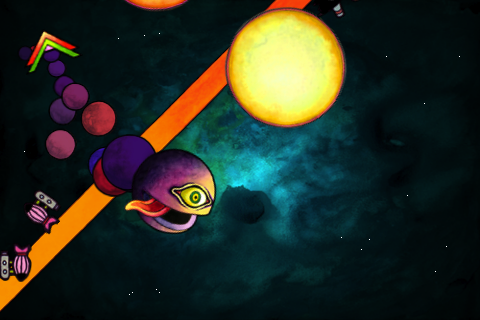
[This is a guest review by tim_the_tam. If you’re interested in writing an article for TIGSource, please go here.]
What is a game? Does it have to be something fun to play? Do you need to be able to win or lose? Does it need a clear objective? Is it a series of choices? Kometen is a “game” that will mess with some people’s ideals of what a game is, which is no surprise coming from the guy who made Blueberry Garden. It’s because Kometen is not a “traditional” game as you can’t win or lose – there is no conflict, no official goals, and no way to die. Personally, I consider Kometen a game but I can also see an argument for it to be an interactive screensaver. But let’s not get too bogged down with the definition and for the sake of this article, Kometen is a game.
Sleep Is Death: Pay What You Want
By: Derek Yu
On: May 18th, 2010
I just wanted to drop a quick note about Sleep Is Death, Jason Rohrer’s storytelling game: the game is now “pay what you want” (with a minimum of $1.75 for PayPal and bandwidth). SID has been out for about a month now, and in that time, the SID community has created hundreds of stories and resource packs, which are free to download for players to use with the game. One of my favorite stories so far is Shannon Galvin’s Are We Home?, which he created while playing Sleep Is Death with Jason himself. Check it out.
So far I haven’t tried the game – I’ve only read stories outputted by other players, as well as the various previews floating around on gaming websites. As such, I don’t know if I have much to add myself at this point. I will say that I find it interesting how Sleep Is Death is often presented as being a competitive game as well as a cooperative one, like in Brandon Boyer‘s preview (which is subtitled “Brandon Boyer vs. Jason Rohrer”). I’m not sure what to make of that, yet – I guess I’ll have to wait until I co-create my first story!
TIGdb: Entry for Sleep is Death
Uin
By: Derek Yu
On: April 20th, 2010
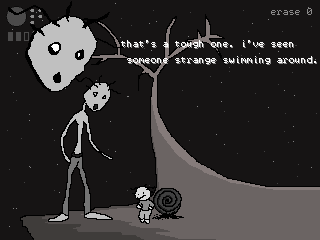
Matt Aldridge, aka “TheAnemic”, aka “biggt”, is best known in the Game Maker community for creating the enigmatic La La Land series of games. In an old interview with Matt regarding the never-released La La Land 6, he explained that the La La Land games “were made after intensively working on another game. I became overwhelmed with the pressure of knowing that I may never finish it. That’s a horrible feeling, especially when you put so much heart into it. These games were like the byproduct of that.” The La La Land games have since become cult hits amongst cult hits, drawing praise from indie developers like Jonathan Blow, Auntie Pixelante, and cactus for their dreamlike qualities.
It’s with that backdrop that we come to Uin, Matt’s first release since La La Land 5 in 2006. Uin is a much more traditional and full-featured game than La La Land, but is still really weird and can be as frustrating as it is surprising. That is due in no small part to the fact that very little is explained about how the game works… whether this is a Good Thing™ or not is up to you, but I’m finding it to be quite enjoyable.
That’s about all I’ll say about Uin. (Note: the download is .zipx, which requires WinZip to unpack. Alternatively, I’ve put up a .zip here.)
TIGdb: Entry for Uin
Ceramic Shooter – Electronic Poem
By: Paul Eres
On: April 13th, 2010
Ceramic Shooter – Electronic Poem by Theta games is a sequel to their earlier 2008 game Ceramic Shooter. Although it was released nearly a month ago, when I went to play it it had only been tried by 10 people. Ortoslon’s video playthrough of the game (above) had far more views as the game had plays; Death Worm had about 15000x as many plays. This was kind of surprising to me considering how good this game is.
I suggest neither watching the video or reading the rest of the review under the jump; just play it first. If you want instructions: avoid breaking stuff for the first half of the game (this is hard, because you can’t stop firing). After playing through it, then watch the video, because it shows some things that you probably missed while frantically trying to avoid shooting stuff. I watched the video first, which made me expect the game to be a lot easier than it actually is (it’s an Ortoslon video).
I found the design and music of this game top-notch; the sprites and graphics less so, but this is freeware. I especially liked how the music was in tune with the stuff that you have to avoid.
The concept for the game was also something I’ve been working on and thinking about for a while: an action game that isn’t about shooting everything, but still feels like an action game, with the same intensity. And this was achieved here, through a simple reversal: you have to move quick to avoid shooting things, because you can’t stop shooting. It’s certainly one way to do it. Maybe there are more.
There’s a trade-off in the game: if you stay near the bottom of the screen, you’re less likely to run into things and destroy them with your ship. But you then generate a long string of shots, which will destroy things more often. If you move to the top of the screen, you aren’t very likely to shoot anything at all (since your shots immediately go off screen), but you’re more likely to crash into things as they come into the view. How the player handle’s this trade-off is important; I usually kept myself in the middle of the screen.
The climax of the game comes about halfway in, when you’re finally able to shoot things (and encouraged to), although your real goal is to paint the screen full of color. That point is what makes it feel like a crime to me that this game had only 10 plays (hence this review). I hope to see a lot more from Theta Games.
Knot-Pharmacard Subcondition J
By: Guest Reviewer
On: March 31st, 2010
[This is a guest review by Stephen Lavelle. If you’re interested in writing an article for TIGSource, please go here.]
Knot-Pharmacard Subcondition J, by Michael Brough (epilepsy warning!).
I would recommend playing the game before reading on…
There is something very beautiful about the nature of the delicate and tentative interactions that can occur when encountering an unfamiliar system for the first time. Glum Buster is probably the canonical example for me. However, in this case the experience for me is one of interaction without surety of the nature of the effect – even after the fact: “I am doing something, but I am not sure what and I am not sure what effect it is having – nonetheless, it feels meaningful”.
Michael’s description, which I think deserves inclusion, reads:
The towlr games are not far removed from KPSJ experientially – they present situations with unknown mechanics – though I think they tend to be far more targeted at understanding (though I enjoy not understanding them as much as I enjoy understanding them). Pandora’s Gearbox comes to mind as well, though I think this is crucially different from all the other games mentioned because, in spite of hiding things, it allows for physical intuition, and relies on such reasoning.
One might say that KPSJ, Glum Buster, and the towlr games rely on a certain sort of ludic knowledge and intuition of their own, though I think the nature of this familiarity is very different to mechanical knowledge.
If one departs from systems that involve logical deduction, one can end up in a situation where exploration takes the form of an exhaustive search of a set range of interactions. This happened in GB sometimes, though I didn’t find it too much of an issue there. This happens when I play towlr games, though usually none of them work and it’s more a piece-of-mind exercise while I try to formulate other possible effective interactions and test the water. This doesn’t happen for me in KPSJ – I generally found myself overwhelmed by effect.
Some of Michael’s other games can be found here.
Let’s Win Forever
By: fuzz
On: March 4th, 2010
“Mouse click on gerbils to shoot them, get scores, youre winning, YOU ARE WINNING FOREVER”
Let’s Win Forever is the latest creation of Amon26, from whom sprang the wonderful Au Sable series and a number of other short, humorous titles. In Let’s Win Forever, the player aims their crosshair at the members of a large crowd of colourful gerbils. Shooting them results in their gaining jetpacks and a seemingly arbitrary number being added to the player’s score. There’s not really any objective or purpose to the game, but that’s okay since it allows you to WIN FOREVER (!). The music is quite brilliant, as always with Amon’s work. If you enjoy this, it’s also worth checking out the more experimental Let’s Win Everything.
Download Let’s Win Forever here; get Amon26 merchandise (including art-books and a CD of Au Sable/AOOFAD) here.
Hit the jump for an interview with Amon26:
with Amon26
TIGSource: What
does the pseudonym “Amon26” mean?
Amon26: I was fourteen when I found the name. Amon was short for Amontillado, and in junior high my friends and I talked about each other and our crushes in-code so that our peers wouldn’t find out our secrets. There was Eduardo, Oxy, Aim, Julius, Pizarro, and me, Amontillado. The 26 came in when I was tired of everybody using the same boring numbers like 69, or 666, 13, or 420. It seemed every number had some kind of special meaning. I couldn’t find any special meaning to the number 26 so I chose it to represent me. I let it become my ‘holy number’ I guess you could say.
TIGS: While you’re best known for your games, you’re also a prolific musician, visual artist, and occasional writer. How do you balance your multiple artistic interests?
Amon26: I don’t worry that much about balancing it out. For a long time I’ve liked the idea of trying to bring multiple elements to bear in a way that excites an audience. So sometimes I’ll write a story that becomes a picture, or I’ll design a picture that becomes a short film. I tend to think in fractals, so everything could be easily transformed into another media for me. AOOFAD could be a board game, or a 200 page poem, or a coffee table art-book. It just happened to come out shaped like a game. :)
TIGS: Where do you think games stand as a medium? Do you consider Anna Anthropy’s concept of games being primarily about creator-audience interaction to be worthwhile, or do you tend to focus more on your own individual expression?
Amon26: I think each game should be measured by its own merit. Boardgames for example: Mahjong can’t be compared to Brenda Brathwaite’s Train, or vice-versa even even though they’re both boardgames. Sometimes a game is meant to tell a story or have a message, sometimes a game is meant to realistically simulate an event, other times its just meant to look and feel cool with little or no substance and meaning. The whole “games as/are art” debate is hard for me to understand. The concept of what makes art art is so hard to pin down as it is. I think what matters more is setting out to try and accomplish something good, regardless of what it may be considered in the end
TIGS: All of the games set in the world of Au Sable are in traditional genres, as either run-and-gun or first person shooter. Is this due to a design philosophy that one can most easily distort what is already well known, or simply from the route of attempting to marry gameplay to aesthetic in a way that doesn’t require a great deal of coding?
Amon26: At first it was my way to make sure I wasn’t overstepping my bounds. I re-purposed a free, open source platformer example for GameMaker and didn’t want to design a game that had goals more complex than I knew I could accomplish with what limited skill I had. Now that I’ve learned more, I could try something less conventional but I’ve always been
fond of John Carmack‘s concept of simplicity. You can play Doom1 with a couple keys and the mouse, that’s all you need.
TIGS: What are a few of your major influences, in any medium?
Amon26: Hm, Castlevania II really helped me see potential in making lo-fi graphics unsettling, the whole game gives this stark sense of loneliness even when you’re in a populated town. Same with Wizards and Warriors 2. Silent Hill/Fatal Frame were good examples of creating a vulnerable player; someone who wasn’t good with guns or combat. As far as books go, I used Ray Bradbury’s “Death Is a Lonely Business” as inspiration for creating an eerie mood from what would otherwise be
considered mundane. Also “House Of Leaves” created an illusion that the book was shredding itself apart as you progressed. I listen to a
lot of music all over the board, from Lilly Allen to Soul Coughing. I modeled AOOfAD/AuSable’s music after Throbbing Gristle, and the
ambient tracks off of the Quake1 CD written by Trent Reznor.
TIGS: Your games tend to employ a glitch aesthetic in that there’s no definite reality that is readily understood by the player, making them unsure of their abilities and goals. To what extent is this
intentional, rather than accidental as a result of your unfamiliarity with your tools?
Amon26: Well a lot of those glitch and scratch concepts come from “manufactured accidents” during the development process. I.E the Eyes in Ausable. I wanted them to do something other than hover in a
fully predictable pattern, so I made attempts to break the game on purpose with lots of random integers, particles, distortions. Once I found something that looked good, I toned it down to a point that kept the game playable, but reflected that sense of nearly crashing. That’s pretty much how I do everything.
TIGS: Collaboration is obviously something that you’re familiar with, as you’ve done the music for both Anna Anthropy‘s and Jazzuo’s games. To what extent has this been a positive influence on your own work?
Amon26: Mighty JillOff and Sexy Hiking have been two heavily played games among my local friends and I for years. We’d spend hours at all-night diners trying to work our way over that damn tree, or up the impossible tower. So when I was invited to compose music for Jazzuo/Anna/Kepa I nearly wet myself! Now, a year later, I’ve learned about who they are, and what they enjoy doing beyond what brought us together. Their friendships have been the most valuable outcome from all of this. I’ve met Anna in person and someday I would like to fly over and visit Jazzuo so we could do a live performance of the DildoTank theme song. I think we would obliterate all of Eurasia with
its greatness. (And some of Denmark)
TIGS: One of the defining features of games as opposed to other artistic mediums is the possibility of a social aspect; this is present even in single player games, as you’ve mentioned in relation to your experiences with The Mighty Jill Off and Sexy Hiking. Do you plan on ever creating a game that focuses as much on human interaction as atmosphere, a la Anna Anthropy’s Octopounce?
Amon26: I have this really crazy idea for a 2 player game that actually encourages failure to some degree. I loved how the later ps2 Burnout games rewarded you with super-dramatic visuals when you failed. I want to recreate that same sense of “oh man, I lost the round but look how amazing my failure was!”
TIGS: Do you have any tips for complete beginners to Game Maker or independent game development in general?
Amon26: hmm.. well it applies to more than just GameMaker, but; Make lots and lots and lots of mistakes. Visit forums, grab examples and code and just rip them apart. Even if you dont know what you’re doing, you’re still doing something. Eventually it gets clearer.
its not effective for people who want to go from zero-to-awesome in a day, but its really rewarding
also, make friends with other small devs, cultivate meaning partnerships with other fledgling designers and share your experiments between eachother.
if it wasn’t for the help of glyph, the A.I in AuSable would be little more than bouncing do-nothings.
TIGS: I see that’s worked out very well for you and Anna Anthropy.
Amon26: exactly, she really took me under her wing and spends lots of time helping me fine-tune things. In return, I’m her “piano monkey” writing fun music for her work.
TIGS: Are you doing the soundtrack for her new deep sea diver game, too, then?
Amon26: It’s planned, I’ve had really bad writer’s block with music lately. Winter gets me down and makes it hard for me to focus on things, but I sent her a few blurbs of music today Ages ago, now- Ed..to see what she thinks.
it’s a lot of fun, there’s stuff I cant discuss about it that really amuses me. Very much her sense of humor.
TIGS: Your Quake machinima tend to have a comical aspect not present in your games or music (aside from the Dildo Tank theme). Is it less natural for you to make humorous, rather than melancholy, creations?
Amon26: I struggle with chronic night terrors. I’ve had them since I was a child and they’re very distracting. One time I had a therapist that encouraged me to try “trapping” my horrors on canvas but It
didn’t work out really well. The pictures didn’t make me feel any better. But it all changed the moment I personified a nightmare as an NPC, took aim, and killed it.
In my ordinary waking-life I tend to be very light hearted, positive and quirky. I avoid over-exposing myself to negative things, I don’t read the news or watch TV. So when I’m in the spirit and feel it’s time to tell a really good joke, I do it by whatever means necessary. I look forward to creating a really absurd and hilarious game in the
future. Something that I hope will equal the polish of AOOFAD/AuSable.
TIGS: Have you played any of Aliceffekt‘sgames? They’re quite reminiscent of yours, especially Cyanosis Fever.
Amon26: ooh this looks interesting (downloading valp.zp)
angon a sec, trying it
ohh MAN!
i never knew i could feel that way about a game.
valential hopes just made me keep going “YES! FASTER! YES!” then i ate some mints, and i was allright.
im not sure what its about yet, i just tried the first path
yeah, i’d really love to develop something alongside a programmer with some genuine 3d prowess. I have an idea for a flight game that I’m not nearly smart enough to make yet.
I tried unity, but it made my brain explode out my ear,
TIGS: It appears that you’ve tried to sell some of your work on CD and USB locally as well as on-line; has this been successful?
Amon26: The money I’ve made off sales doesn’t cover much more than a nice dinner or a DVD on occasion, but I don’t expect it to. It’s just my way of providing people a method to donate money and be able to get something nice in turn as my way of saying thanks. I wish I could curb production costs though, I make 2 dollars profit off a 18 dollar shirt.
TIGS: You’ve recently made the jump into 3D; how is designing for three dimensions different than designing for a spatial area seen only from one side?
Amon26: It was a nightmare at first, but I was sort of expecting that. Even though all I was doing was providing a variable for “height” along with width and length, it took a lot of re-thinking to
understand. Once I started getting the basics down It actually felt very familiar. Cactus helped me solve a problem that was a bit tedious but he really saved my ass. Without his tip, The Hunt still wouldnt run right on most PC’s. I really need to look into Unity and
see if I can make anything interesting in that next, but I’m not sure if my brain can handle it. We’ll see. If i start speaking aramaic and drawing stick figures of zalgo with my own feces, then maybe i’ll stick to 2d a little longer.
You can ask Amon26 your own questions at his Formspring.
